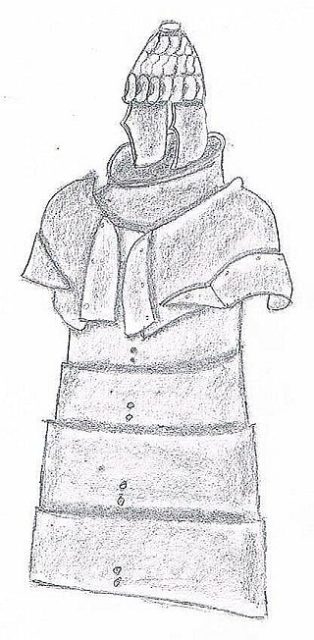The Mycenaean Era in the history of Greece represents the beginning of the advanced Greek civilization.
During this last phase of the Bronze Era, the Greeks developed their writing system, art, and the urban organization. Engineering, architectural and military innovations were introduced, taking the Greek society to a higher level.
With the establishment of the new trading routes and the growth of the economic power, new hierarchical, political and social systems rose throughout the newly formed Greek palace states. The era, which lasted from circa 1600 until circa 1100 BC, got its name from the city of Mycenae in the Argolis region, which today is the most prominent archaeological site from this era. This was the period when Greece got its first elite warrior units, so, understandably, the first armor was made exactly in the Mycenaean era.

The earliest sample of a full body armor in Greece was found at the Dendra archeological site, located in the Argolis area. Discovered in May 1960 by Swedish archaeologists, the discovered breastplate, and backplate made of bronze, date to the 15th century BC. These pieces are part of the Dendra full-body armor, composed of fifteen pieces, including leg protectors, arm-guards, helmet and the parts mentioned above. The pieces were held together with leather lacing, covering the entire body of the soldier.
The breastplate and backplate are linked on the left side by a hinge, and together with the large shoulder protectors, these pieces consisted the upper body armor. Two triangular-shaped plates are attached to the shoulder protectors, providing protection for the armpits. The armor also includes a neck protection plate. Three pairs of curved shields hang from the waist, giving protection to the groin and the thighs. This artifact is unique for its armguard, and as for the leg protectors, it is assumed that they were made of linen and are a standard piece of armor seen in illustrations from the Mycenaean age.

Written proofs of the existence of similar armors are found in other places, like Knossos, Pylos, and Tiryns. However, the Dendra panoply is by far the oldest example ever to be unearthed. The beaten bronze plates on this armor are loosely fastened with leather stripes, all in order to ease the movements of the warrior.
Together with the bronze pieces, slivers of boar’s tusks were also unearthed, which were pieces of the boar’s tusk helmet. The full armor forms a heavy tubular suit and protects the entire body of the soldier. Thеre are examples of body armors from Mycenaean age displayed at the National Archaeological Museum in Athens, but these pieces are different from the one found at Dendra.

The Dendra archaeological site is located outside the Dendra village, which belongs to the Midea municipality in the Argolis region of Greece. The history of Dendra began in the early Bronze Age, and many important discoveries were made there. The excavations began in the beginning of the 20th century when a cemetery was discovered by the Swedish archaeologist, Axel Persson, who discovered many beehive and chamber tombs.
The scientists assume that these tombs belonged to the ruling class of citizens who lived near the magnificent citadel of Midea. Later, the excavations exposed the existence of earlier burial sites which had the remains of sacrificed horses. The archaeologists made many important discoveries at Dendra, including jewelry, precious stones, tools and weapons, golden items and pieces of pottery. Items made out of silver, copper, glass and ivory were found as well. However, the Dendra panoply remains the most important discovery made on this site and is now on display at the Archaeological Museum in the seaport town of Nafplio.
